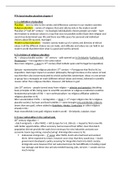PTA Social studies pluralism chapter 4
4.1) a definition of pluralism
Pluralism – term to refer to the variety and differences common in our modern societies
Religious pluralism – variety of religions that exist side-by-side in the modern world
Pluralism 2nd half 20th century – increasingly individualistic choices people can make – have
the freedom to embrace values in a way that was not possible earlier (back then religion and
social class determined your life and there was little space for personal and individual
choices about life eg work, marriage)
Modern cultural pluralism – modern society made up of a variety and diversity of ethical
values (=all the different choices we can make, and attitudes and values we can hold in our
modern world that determine what is a good and worthy person)
4.2) a history of religious pluralism
NL -> always pluralist society – 16th century – split opened up in Christianity (Catholics and
Protestants) -> live together in the same nation
Also more religions -> Jews in 17th century (fled Catholic spain and Portugal bo Inquisition)
Spinoza- representative religious pluralism 17th century -> Portuguese that fled to NL bo
inquisition. Had major impact on western philosophy through his ideas on the nature of God,
was therefore also excommunicated by Jewish authorities Amsterdam. Ideas: no one person
or group has a monopoly on truth (different ethical values and views), believed in scientific
reason rather than religious intuition. However, did believe in god
Late 20th century – people turned away from religion -> atheists and agnostics (doubting
basic principles of life, being open to scientific secularism or religious creationism could be
fundamental principle of life) -> non-confessionalism/ no religious affiliation added to
religious pluralism in NL
After secularization 1970s -> immigration -> Islam (-> 4th major religion into NL’s religious
pluralist society), Surinam and Dutch Antilles (-> some brought new polytheistic religions
(more than one god), others added to Buddhists, Hindus, Confucians or other religions
already in NL)
Main monotheistic (one god) religions modern world – Christianity, Judaism, Islam
4.3) new nationalities in the netherlands
20th century migration ->
- dutch emigrants -> after WW2 -> left Europe for S-A, USA etc -> hoped to find a new life
with better opportunities. When economy had recovered from WW2, clear that dutch
population did not provide the work force necessary for new industries and post war
economic boom (eg mining, manufacturing) immigration waves to NL
Indonesian immigrants – 1st wave: after WW2, dutch who had lived and worked
there. Were expected to return, however once clear that they would stay -> dutch
government developed a policy ensuring for integration back into dutch society.
Immigrants were however first not welcomed since NL had difficulty in funding repair
war damage and these new arrivals needed housing, jobs, services -> would cost too
much money
, Mollucan immigrants – 2nd wave from dutch colonies 1951 – had helped dutch
military when Indonesia tried to gain independence (1945-1949) and were brought to
NL since they could no longer live in Indonesia. NL government hoped for a separate
Moluccas entity in Indonesia and so Mollucans were not integrated in society and
were housed in camps, segregated -> this thought is the basis of the problematic
integration of the Mollucans in NL
Immigrants from the Mediterranean – 1960s – because of employment opportunities
bo post war reconstruction NL and some hoped to escape unemployment in own
country (eg Spain, Italy -> mining). Later, in 1970s, immigrants for work from
Morocco (=textile), Tunisia, Turkey economic migrants
integration mediterranean countries -> dramatic -> were expected to return home after
period of work. When clear many wanted to stay, dutch government expected that they
would retain their cultural and national identity -> policy planned on this thought ->
education in own languages -> bad integration
Dutch Antillean and Surinamese immigrants – after decolonization – suriname most
acute problem -> huge numbers in 1970s -> were Dutch citizens so had constitutional
right to settle, but were seen to be involved in crime and have low integration
chances -> politicians disagree whether restrictive regulations should be introduced
on immigration Suriname, Antilles SamKalden (minister president at the time) ->
restricting immigration or dutch nationality rights of surinamese nationals legally
possible, politically undesirable. Next: left -> Den Uyl -> negotiations political leader
suriname Surinamese exodus to the Netherlands on the eve of independence
After independence agreement that Surinamese still had dutch naturalisation rights
for 5 years (up to 1980) arrivals strained capacity local facilities to house and
education, trained and educated people leaving suriname (=problem), racial tensions
in NL (particularly in cities with many arrivals)
Integration -> not sure whether they would stay -> twin-track policy by dutch
government -> promote return to own country and integration in dutch society (-
>assumpted many would stay)
Policy revisions on integration -> growing number immigrants -> strained facilities eg
education, social services, housing. Also in 1980s first economic downturn since the war ->
guest workers were no longer needed and recruited. Hoped that independence suriname
would stop huge migration Surinamese (happened in 1980, see above)
End 1970s -> clear that many would stay and wanted family reunion (importance integration
higher) -> revised policy surrounding immigration, integration, cultural identity and
assimilation needed.
Also import brides and import bridegrooms, mostly from morocco and turkey -> to stem
down immigration -> restrictions on family reunion -> fe must earn 120% dutch minimum
wage, min 21 yo -> import brides and grooms dropped
In 2012 -> reverse migration -> immigrants returning back to country of origin. However,
expect a further growth of Turkish and Moroccan communities in NL





